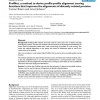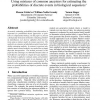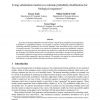197 search results - page 17 / 40 » Improving pairwise sequence alignment accuracy using near-op... |
BMCBI
2005
14 years 11 months ago
2005
Background: Profile-profile methods have been used for some years now to detect and align homologous proteins. The best such methods use information from the background distributi...
ISMB
2001
15 years 1 months ago
2001
Accurately estimating probabilities from observations is important for probabilistic-based approaches to problems in computational biology. In this paper we present a biologically...
106
click to vote
JCB
2002
14 years 11 months ago
2002
Accurately estimating probabilities from observations is important for probabilistic-based approaches to problems in computational biology. In this paper we present a biologically...
BMCBI
2004
14 years 11 months ago
2004
Background: The prediction of ancestral protein sequences from multiple sequence alignments is useful for many bioinformatics analyses. Predicting ancestral sequences is not a sim...
GECCO
2004
Springer
15 years 5 months ago
2004
Springer
Aligning multiple DNA or protein sequences is a fundamental step in the analyses of phylogeny, homology and molecular structure. Heuristic algorithms are applied because optimal mu...



